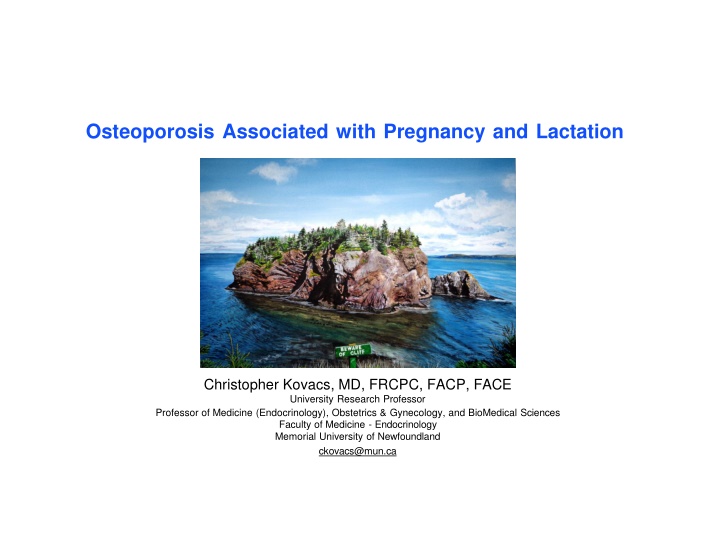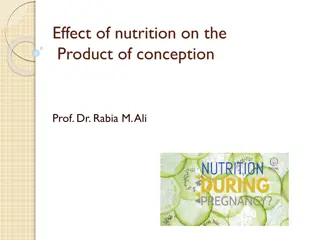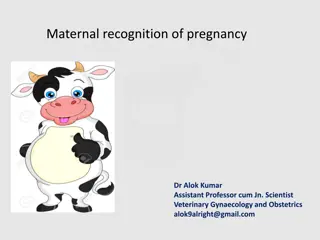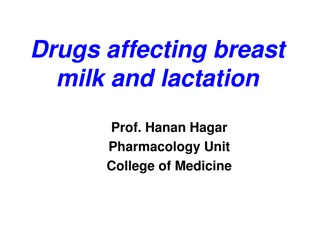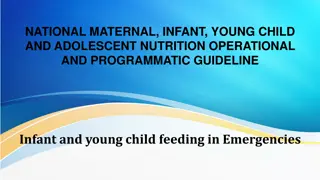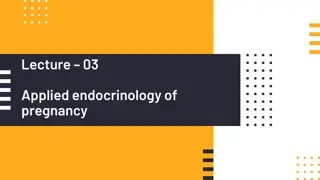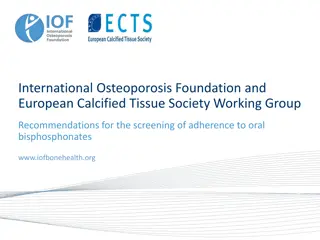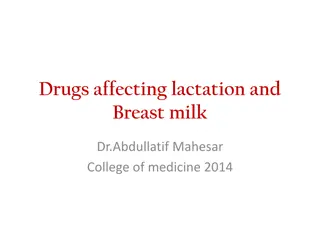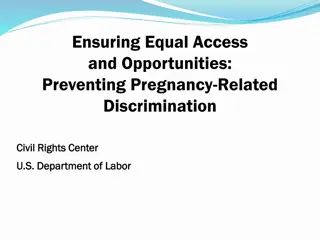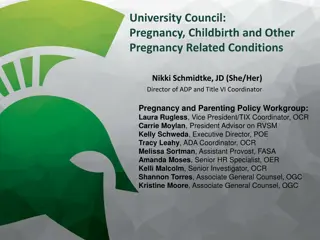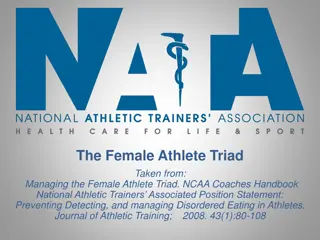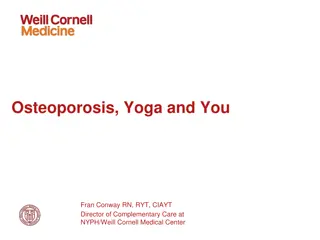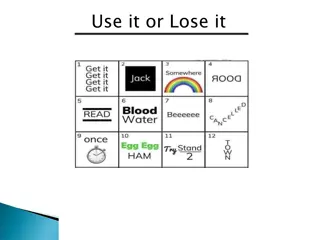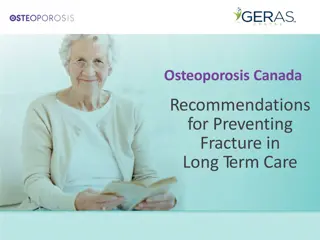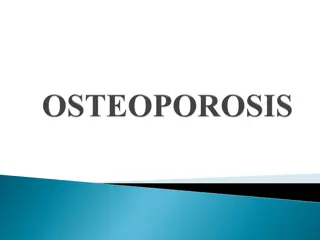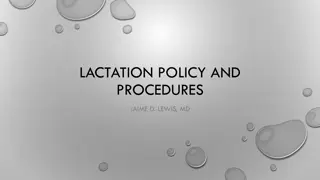Osteoporosis Associated with Pregnancy and Lactation
Dr. Christopher Kovacs presents three intriguing case studies related to osteoporosis associated with pregnancy and lactation. The cases showcase the impact of various factors such as inadequate milk production, medication use, dietary habits, and familial history on bone health. These cases highlight the importance of comprehensive care and awareness in managing osteoporosis in women during and after pregnancy.
Download Presentation

Please find below an Image/Link to download the presentation.
The content on the website is provided AS IS for your information and personal use only. It may not be sold, licensed, or shared on other websites without obtaining consent from the author.If you encounter any issues during the download, it is possible that the publisher has removed the file from their server.
You are allowed to download the files provided on this website for personal or commercial use, subject to the condition that they are used lawfully. All files are the property of their respective owners.
The content on the website is provided AS IS for your information and personal use only. It may not be sold, licensed, or shared on other websites without obtaining consent from the author.
E N D
Presentation Transcript
Osteoporosis Associated with Pregnancy and Lactation Christopher Kovacs, MD, FRCPC, FACP, FACE University Research Professor Professor of Medicine (Endocrinology), Obstetrics & Gynecology, and BioMedical Sciences Faculty of Medicine - Endocrinology Memorial University of Newfoundland ckovacs@mun.ca
Disclosure No relevant conflicts of interest This area is both a clinical interest and a research focus for me
Case Presentation - 1 Age 35 with ankylosing spondylitis, treated with a TNF blocker Uneventful first pregnancy and began breastfeeding Lactation consultant advised that baby s slow weight gain meant inadequate milk production Instructed her to pump in between feeds and store (not use) the milk (!) Pumped and stored as much milk as her baby received directly through nursing Two months into breastfeeding, felt increasing back pain Rheumatologist adjusted her meds but no relief from pain Bent over to move her baby in the car seat: felt and heard a loud crack in her back Presented to orthopedics and referred to endocrinology in Calgary Disclosed when I saw her several years later
Case Presentation - 2 Spine radiographs showed compression fractures of 30% at T11 and 40% at T12, accompanied by endplate depressions at L2, L3 and L4 (These radiographs were done several years later at my institution)
Case Presentation - 3 Vegetarian with high phytate intake Habitual calcium intake of 750 mg daily; 250 mg supplement during pregnancy to reach 1,000 mg daily (vs. 1,200 mg optimal intake) Habitual vitamin D intake 3,800 IU daily through supplements Determined when I saw her several years later Ulnar fracture at age 12 when she was pushed down on the schoolyard Ankle fracture at age 17 when she fell downstairs Twice she had 3-week courses of prednisone for asthma (15 mg starting dose) Attention deficit hyperactivity disorder, postpartum depression, iron deficiency, mild psoriasis, periodic vertigo Sister has low bone mass ( osteopenia ) but no fractures
Case Presentation - 4 Workup for secondary causes of bone loss was otherwise unremarkable Whole genome sequencing found no mutations in any genes related to osteoporosis, bone mass, or bone metabolism At 6 months postpartum, while still breastfeeding, Lunar DXA revealed severe bone loss at the lumbar spine: Lumbar spine 0.645 g/cm2 or Z-score -3.6 Total hip 0.736 g/cm2 or Z-score -1.6 Femoral neck 0.542 g/cm2 or Z-score -2.6 At 8 months postpartum, HR-pQCT showed very low trabecular bone volumes in the left radius and tibia
Mineral demands during pregnancy Average human fetus at term has: 30 g of calcium 20 g of phosphorus 0.8 g of magnesium 80% is accreted during the third trimester The rate of accretion averages 150 mg calcium per kg fetal weight daily 60 mg per day at week 24 300-350 mg per day between the 35th and 40th weeks Kovacs CS. Physiol Rev 2016; 96:449-547
The potential calcium deficit Recommended calcium intake (non-pregnant or pregnant) is 1,200 mg per day In reproductive age North American women: 50th percentile of calcium intake is ~800-1,000 mg daily (varying by age and ethnicity)* ~25% of dietary calcium is absorbed Net absorption is 200-250 mg of calcium This is insufficient to meet the fetal demands in the third trimester, and well below the combined requirements of mother and fetus Assuming 25% absorption, would require an extra 1,400 mg daily to provide the 350 mg the fetus needs during the late third trimester Institute of Medicine, Dietary Reference Intakes for Calcium and Vitamin D, 2011 *NHANES and Health Canada data Kovacs CS. Physiol Rev 2016; 96:449-547
Maternal adaptations during pregnancy 80% of calcium is actively transported to the fetus in third trimester Doubling of intestinal calcium absorption begins in 1st trimester Calcium balance studies predict maternal skeletal mineral content must be increased during the first half of pregnancy Concurrent 2 to 5-fold increase in calcitriol (active vitamin D) Kovacs CS. Physiol Rev 2016; 96:449-547
Calcium Intake Pregnancy Serum calcium falls due to albumin Ionized calcium normal PTH low* Calcitriol increases 2 to 5-fold PTHrP increases steadily Estradiol increases up to 100x Calcitonin increased Serum Ca++ Urine Intestinal calcium absorption doubled *exception: women from Asia and Africa with very low calcium or high phytate intakes PTHrP = PTH-related protein Kovacs CS and Kronenberg HM. Endocr Rev 1997; 18:832-872
Maternal kidneys not placenta are the source of calcitriol during pregnancy in rodents and women Anephric women have low, unchanging calcitriol before and during pregnancy1 In mice, maternal absence of Cyp27b1 (the enzyme that creates calcitriol) obliterates the rise in calcitriol2 1Turner M. Miner Electrolyte Metab 1988; 14:246-252 2Gillies B. J Bone Miner Res 2018; 33:16-26
Calcitriol increases during pregnancy without PTH Inferred that calcitriol rises during pregnancy in hypoparathyroid women in whom supplemental calcitriol needs are reduced or eliminated Confirmed in aparathyroid rodents, including mice lacking the gene encoding PTH Sweeney L. Endocr Pract. 2010; 16:459-462 Kovacs CS. Physiol Rev 2016; 96:449-547 Kirby BJ. J Bone Mineral Res 2013; 28:1987-2000
Intestinal calcium absorption increases during pregnancy in rodents without calcitriol, VDR, or vitamin D Kovacs CS. Physiol Rev 2016; 96:449-547 Ryan BA. J Bone Miner Res 2022; 36: 2483-2497
Key points about pregnancy The fetal demand for mineral is met by increased intestinal absorption But if net calcium intake is low, the maternal skeleton must be resorbed The increase in calcium absorption is driven in part by an increase in calcitriol, but it s also driven by unknown factors independent of calcitriol More than one mechanism kicks in to ensure calcium delivery Consequently, calcium delivery is maintained despite severe vitamin D deficiency
Causes of skeletal fragility associated with pregnancy Nutritional Low dietary calcium intake Dairy avoidance Lactose intolerance Low vitamin D intake/vitamin D deficiency High phytate intake Anorexia nervosa Hormonal Excess PTHrP from placenta or breasts* Primary hyperparathyroidism Hyperthyroidism Cushing s syndrome Chronic oligoamenorrhea Hypothalamic amenorrhea Pituitary disorders leading to sex steroid deficiency Premature ovarian failure Gastrointestinal Celiac disease Crohn s disease Cystic fibrosis Short bowel from resections Other malabsorptive disorders *each source has also been found to cause hypercalcemia in pregnancy Kovacs CS and Ralston SH. Osteoporos Int 2015; 26:2223-2241
Causes of skeletal fragility associated with pregnancy Mechanical Petite frame Low body weight Low peak bone mass Excess exercise Increased weight-bearing of pregnancy Lordotic posture of pregnancy Bedrest Incomplete recovery from prior lactation? Pharmacological GnRH analog treatment Progestin-only contraceptives Glucocorticoids Proton pump inhibitors Heparin Certain anti-seizure medications (phenytoin, carbamazepine) Cancer chemotherapy Alcohol Renal Hypercalciuria/renal calcium leak Chronic renal insufficiency Renal tubular acidosis Kovacs CS and Ralston SH. Osteoporos Int 2015; 26:2223-2241
Causes of skeletal fragility associated with pregnancy Primary disorders of bone quality* Osteogenesis imperfecta (COL1A1/1A2 mutations) milder forms Osteopetrosis and other sclerosing bone disorders LRP5 inactivating mutations Wnt1 mutations Rheumatological disorders Rheumatoid arthritis Systemic lupus erythematosis Other non-specified genetic disorders Family history of osteoporosis or skeletal fragility Positive genetic screen for other bone disorders Connective tissue disorders Ehlers-Danlos syndrome Marfan syndrome Idiopathic osteoporosis Being a primipara *not known prior to pregnancy Kovacs CS and Ralston SH. Osteoporos Int 2015; 26:2223-2241
Osteoporosis presenting during pregnancy Occasionally vertebral crush fractures occur during late pregnancy Exact frequency unknown Back pain is common during pregnancy; compression fractures may be overlooked Some evidence that appendicular fractures may be more common1 Baseline or pre-pregnancy bone mineral density (BMD) usually unknown May be due to a combination of factors shown on preceding three slides Recommend (my opinion): Conservative management and postpartum investigations into bone health Expect a spontaneous postpartum increase in BMD by 10-20% May be advisable to avoid breastfeeding 1 Herath M. Arch Osteoporos 2017; 12: 86 Kovacs CS and Ralston SH. Osteoporos Int 2015; 26:2223-2241
Separate disorder: transient osteoporosis of the hip AKA localized or regional migratory osteoporosis; bone marrow edema syndrome Not due to systemic resorption of the skeleton A form of chronic regional pain syndrome type I or reflex sympathetic dystrophy Can occur equally in men and non-pregnant women Women present during the third trimester or early postpartum with hip pain, limp, or hip fracture; occasionally, both hips are involved Radiographs show osteopenia and radiolucency of femoral head and neck DXA shows low hip BMD whereas spine is normal or not as reduced MRI shows edema of femoral head and marrow DXA and MRI findings typically resolve within 2 to 12 months; BMD may increase by 20-40% Kovacs CS and Ralston SH. Osteoporos Int 2015; 26:2223-2241
Lactation Neonate requires an average of 210 mg of calcium daily through milk during the first six months Between 6 to 12 months the infant requires about 260 mg of calcium daily 120 mg per day from milk 140 mg from solid foods Nursing twins or triplets respectively doubles and triples the maternal calcium output Maternal intake and absorption of calcium is typically insufficient to meet the demands of milk production but it doesn t matter Kovacs CS. Physiol Rev 2016; 96:449-547
Maternal adaptations during lactation Temporary loss of bone mineral to provide ~210 mg calcium daily to milk 5-10% loss of BMD in 2-6 months for women trabecular > cortical vertebral > appendicular Renal calcium conservation Intestinal calcium absorption is normal (non-pregnant rate) Kovacs CS. Physiol Rev 2016; 96:449-547
Greater decline in BMD with longer duration of lactation More C. Osteoporos Int 2001; 12:732-737
Randomized intervention: 1 gram of supplemental calcium does not prevent lactational bone loss Kalkwarf H. N Engl J Med 1997; 337:523-8.
Lactation Calcium Intake Serum calcium normal Ionized calcium normal or slightly increased PTH low Calcitriol normal PTHrP increased Calcitonin increased for first six weeks, then normalizes Estradiol low Prolactin elevated Serum Ca++ Urine Breast Milk Kovacs CS and Kronenberg HM. Endocr Rev 1997; 18:832-872
Brain, breast and bone circuit GnRH LH, FSH E2, PROG OT PRL PTHrP and low estradiol (and possibly additional factors) drive bone resorption during lactation Ca2+ Ca2+ Ca2+ CT Ca2+ Ca2+ Ca2+ PTHrP Ca2+ CT = calcitonin E2= estradiol OT = oxytocin PRL = prolactin PROG = progesterone Kovacs CS. J Mammary Gland Biol Neoplasia 2005; 10:105-118
Hormonal changes drive osteoclast-mediated bone resorption and osteocytic osteolysis Ryan BA and Kovacs CS. J Clin Invest 2019; 129: 3041-3044
Osteocytic osteolysis controls osteoclast-mediated resorption Osteocytes express enzymes (cathepsin K, TRAP) and secrete acid, similar to osteoclasts Loss of the PTH receptor from osteocytes reduces both osteocytic osteolysis and osteoclast-mediated bone resorption Loss of cathepsin K from osteocytes reduces osteocytic osteolysis, osteoclast- mediated bone resorption, and osteoclast number Products released from the matrix must signal to osteoclasts; without them, osteoclast recruitment and activity are reduced during lactation Ryan BA and Kovacs CS. J Clin Invest 2019; 129:3041-3044 Lotinun S. J Clin Invest 2019; 129: 3058-3071 Qing H. J Bone Miner Res 2012; 27: 1018-1029
Calcitonin acts as a brake on bone resorption during lactation (at least in mice) Woodrow JP. Endocrinology 2006; 147:4010-4021
Key points about lactation The neonatal demand for minerals in milk is met largely by maternal bone resorption, independent of dietary calcium intake and absorption Low estradiol, in combination with high circulating concentrations of PTHrP secreted from the lactating breasts, stimulates this bone resorption A temporary loss of maternal bone strength is inevitable during lactation, but for most women this happens silently with no consequences
Causes of skeletal fragility associated with lactation All of the factors previously listed for pregnancy, plus: Hormonal Normal or even excess lactational bone loss, mediated by PTHrP and low estradiol* Mechanical Carrying, bending, and lifting maneuvers with baby and related paraphernalia Other Increased breast milk output (e.g., nursing twins) Prolonged duration of exclusive lactation *This PTHrP-mediated skeletal resorption is sufficient to cause hypercalcemia in some normal breastfeeding women, and to normalize calcium homeostasis in hypoparathyroid women while breastfeeding Being a primipara Kovacs CS and Ralston SH. Osteoporos Int 2015; 26:2223-2241
Osteoporosis during lactation Occasionally vertebral crush fractures occur during lactation Sometimes it s a cascade of 6 to 10 spontaneous crush fractures, and these cases get reported in the literature; it s unknown how common 1 or 2 fractures might be Back pain is common post-partum; compression fractures may be missed Prepregnancy (baseline) bone density is usually unknown Likely due to bone loss during lactation on top of skeletal losses or inherent fragility that preceded this time period 70-90% of reproduction-associated fractures occur within 2-3 months of lactation Recommend (my opinion): Conservative management with expectation that bone mass will increase after weaning; hold off on use of osteoporosis medications Spontaneous BMD increases of 10-20% and up to 40% have occurred Reserve pharmacotherapy for inadequate responders or more severe cases Kovacs CS and Ralston SH. Osteoporos Int 2015; 26:2223-2241
Estimates of incidence of osteoporosis occurring in association with pregnancy or lactation Of 1,260 thoracic, lumbar, or thoracolumbar MRIs done in women of reproductive age over 2 years at one institution, six women (0.47%) had compression fractures associated with recent pregnancy or lactation1 Mean of 5.6 compression fractures per woman Of 837,347 recent pregnancies, 379 women (4.5 / 10,000) presented to hospital within 2 years due to fractures2 The diagnosis was delayed 12 weeks from the onset of pain in most women3 Explained away as normal back pain expected during lactation 1 Yildiz AE. Osteoporos Int 2022; 32:981-989 2 Toba M. J Bone Miner Metab 2017; 40:748-754 3 Kondapalli AV. Osteoporos Int 2023; 34:1477-1489
Where do the compression fractures occur? Number and location of fractures in 47 cases followed between 2006 and 2018 at one institution in Germany Hadji P. Geburtshilfe Frauenheilkd 2022; 82:619-626
Post-weaning skeletal recovery Return to baseline BMD and presumed bone strength in six to twelve months for most women However, there are persistent changes in appendicular microarchitecture seen by HR- pQCT at the radius and tibia (cannot examine spine and hip by this technique) 1,2 Regulation of skeletal recovery is not understood In the long-term, a history of lactation has a neutral or protective effect against the development of low BMD, osteoporosis, and fragility fractures 1 Brembeck P. J Clin Endocrinol Metab 2015; 100:535-543 2 Bjornerem A. J Bone Miner Res 2017; 32:681-687 Kovacs CS. Physiol Rev 2016; 96:449-547
Epidemiology of parity, lactation, and osteoporosis More than six dozen epidemiological studies have found that parity or lactation (or both) have a neutral or protective effect on long-term risk of osteoporosis, fragility fractures, or low BMD A study of 1,852 twins and their female relatives, including 83 twins who were discordant for pregnancy and lactation, found no effect of breastfeeding history on BMD Parous women who had breastfed had higher BMD than parous women who had never breastfed Paton LM. Am J Clin Nutr 2003; 77: 707-714 Kovacs CS. Physiol Rev 2016; 96:449-547 Segal E. Osteoporos Int 2011; 22:2907-2911
Lactational BMD decline is followed by post-weaning recovery Sowers MF. JAMA 1993; 269: 3130-3135
Lactational BMD decline is followed by post-weaning recovery Kalkwarf HJ. Obstet Gynecol 1995; 86:26-32
Spontaneous BMD increase in women who fractured 13 women at a center in the UK Phillips AJ. Osteoporos Int 2000; 11:449-454
Bone recovery after lactation involves Stimulation of new bone formation Remineralization of existing bone around osteocytes Compensatory increase in diameter of some long bones? Kovacs CS and Ralston SH. Osteoporos Int 2015; 26:2223-2241
What regulates post-lactation skeletal recovery? In animal models, none of the known calciotropic hormones ( the usual suspects ) are required for full skeletal recovery (bone mass and strength) Includes PTH, calcitriol, VDR, PTHrP, calcitonin, estradiol Limited case reports support these findings, such as a documented 40% increase increase in bone mass after weaning in an aparathyroid woman Segal E. Osteoporos Int 2011; 22:2907 2911 Kovacs CS. Physiol Rev 2016; 96:449-547
Bone mineral content (BMC) recovers without PTH Kirby BJ J Bone Mineral Res 2013; 28:1987-2000
Spontaneous and post-pharmacotherapy bone recovery Individual case reports and series have documented spontaneous BMD increases of 10-20% (one case up to 40%) Pharmacotherapy has been used in case reports and series, with reported BMD increases of 10-30% Bisphosphonates; denosumab; teriparatide; romosozumab; calcitonin; strontium ranelate; fluoride; calcitriol (none yet with abaloparatide) There are no randomized trials comparing spontaneous vs. pharmacologically assisted skeletal recovery Most case reports simply report the increase in a treated case and assume nothing would have happened without pharmacotherapy Kovacs CS and Ralston SH. Osteoporos Int 2015; 26:2223-2241
What is conservative management? Optimize calcium and vitamin D intake, and overall nutrition Early mobilization; avoid bedrest Encourage weight-bearing physical activity: must stay active Avoid activities with significant lifting or increased risk of falls Consider avoiding lactation (with pregnancy fractures) Consider weaning baby (with lactation fractures) Physiotherapy to maintain mobility, improve core muscle strength, reduce pain Supportive corset (temporary) for vertebral fracture pain Assess spontaneous recovery of vertebral BMD at 12 18 months (Kyphoplasty or vertebroplasty have been done for persistent pain) Kovacs CS and Ralston SH. Osteoporos Int 2015; 26:2223-2241
Considerations as to why pharmacotherapy isn t the immediate first choice A spontaneous 10-20% or greater increase may occur: wait to see if pharmacotherapy is needed (e.g., unsatisfactory BMD regain) Could pharmacotherapy interfere with natural skeletal recovery? e.g., anti-resorptives blunting the effect of spontaneous anabolism The interval of bone loss is over; why treat with agents that stop bone loss? Anabolics are normally followed by an anti-resorptive or else all gains are quickly lost within a year or two What is the end-point of treatment, and long-term adverse risks, if an anti- resorptive is used in young women? Fracture risk should be low and bone mass stable in reproductive age women All such use is off-label; concerns about teratogenic effects, esp. denosumab Kovacs CS and Ralston SH. Osteoporos Int 2015; 26:2223-2241
If pharmacotherapy is needed, which to choose? Anabolic treatment makes the most sense to increase bone mass and strength if spontaneous recovery is judged inadequate Anti-remodeling agents may not be needed: case reports suggest that anabolic- induced gains in BMD may be maintained in reproductive-age women If anabolics cannot be used or afforded, then anti-remodeling agents (bisphosphonates, denosumab) may be considered Perhaps earlier in the post-weaning phase when spontaneous anabolism is occurring, assuming that their use does not interfere with normal skeletal recovery Kovacs CS and Ralston SH. Osteoporos Int 2015; 26:2223-2241
24 months of teriparatide and 1 year follow-up in 47 cases Treated between 2006 and 2018 at one institution in Germany Afterwards, all women had regular menses or took oral contraceptives Hadji P. Geburtshilfe Frauenheilkd 2022; 82:619-626
107 patients at one center in Germany, 76% treated Followed between 2004 and 2014 at one institution in Germany 25% (26/107) women fractured during median 6 years of follow-up Twice as many fractures occurred in those treated with bisphosphonates, teriparatide, or both as compared to those who were not treated 20% (6/30) women fractured during a subsequent pregnancy/lactation cycle Provided 4.5-year follow-up BMD on 13 women who had been treated: Untreated patients from UK in Phillips AJ. Osteoporos Int 2000; 11: 449-454 Kyvernitakis I Hadji P. Osteoporos Int 2018; 29:135-142
